# The Challenges Faced by Small-scale Coffee Farmers

To learn about our work to assist coffee farmers to better market their coffee, click here.
# Even though coffee has been called "black gold," the average small-scale grower lives in poverty
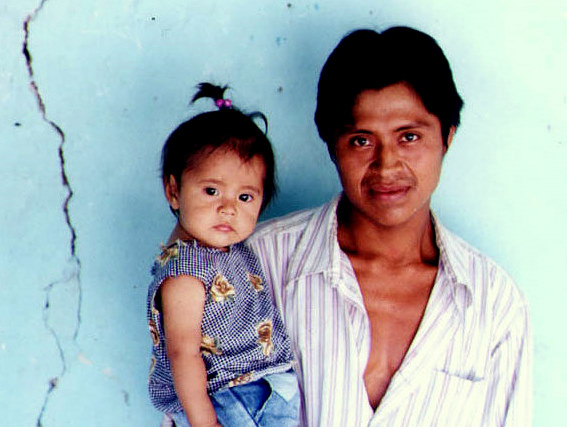
From the rich soils of the steep Sierra Madre Mountains, thousands of "cafetaleros" harvest the coffee that they sell to sustain their families. The average small-scale farm produces about 20 bags of 100 pounds of coffee each year. For the vast majority, coffee is all that cafetaleros have for earning a livelihood. It is a fragile crop that is vulnerable to fluctuations in the weather and requires a great deal of labor. Coffee has made fortunes for some in the industry. But three human-caused factors, environmental degradation, the international pricing structure and the way coffee is bought locally, conspire against coffee families who, despite their honest labor, remain the perpetual poor of the Sierra Madre.
Despite the supposed romance of the idyllic country life depicted in “Juan Valdez” commercials, the truth is that growing coffee has always been a gamble for poor farmers. The deforestation of the Americas, particularly in Chiapas and Central America, has resulted in diminished rainfall during the critical period when the coffee is flowering leading to reduced yields. As climate change worsens, erratic weather further damages crops. In both 1998 and 2005, catastrophic flooding from hurricanes hitting deforested lands caused widespread landslides and flooding and were responsible for the loss of much land that had been cultivated in coffee. With Hurricane Stan, it was estimated that 60% of the crop was lost. An at least 40% of the surface area that had been farmed in coffee was lost in landslides. In an already impoverished region, people may well never really overcome such massive losses.
# Lack of access to credit causes a cycle of debt
Coffee is a costly crop to grow given that it is so labor intensive. With bank loans at 20% interest or more, growers have traditionally had to obtain loans from middlemen, called coyotes, to cover production as described in detail in the article at the end of this section. The loans oblige the indebted grower to give part of the harvest in payment. The rest they sell to the coyotes who buy coffee at low prices and then sell volume to the exporting companies. Most years the coyotes are the only ones in the mountains who make money from coffee.
While the problem of middlemen is troublesome the real structural problem in the coffee industry is the way coffee prices are set internationally. Futures traders making their fortunes in commodities trading on the New York Exchange seem as remote from the realities of life in the Sierra as the capricious Gods on Zion deciding the fate of the humans. Farmers never can predict how much they will earn for each harvest since the vagaries of the international pricing structure can bring misfortune overnight regardless of the care they have given to their trees all year. If previously growing coffee has always been a risk, now that the bottom has fallen out of world coffee prices, for poor farmers growing coffee has become a serious liability.
# From Our Archives: The Coffee Crisis
An estimated 20 million people in 50 countries around the world depend on growing coffee for their livelihood.
Since coffee is a commodity, its value at a given point in the year is determined by the total volume produced worldwide. When volume exceeds consumption, prices plummet. Though Vietnam only recently began to produce coffee it has become the second largest producer after Brazil. In 2001 the unprecedented introduction of this high volume of coffee from Vietnam dramatically depressed world prices. The impact has been absolutely devastating for other producing countries around the world.
A farmer’s cost for producing a 100 pound bag of un-milled coffee averages between $70-90 in Chiapas. When local prices were around $55 in 2001, farmers knew they could not afford the cost of paying the seasonal pickers from Guatemala to harvest their crop. Many desperately tried to convince the pickers work for an even split. Even though they rely on the seasonal income the pickers were unwilling to suffer the hard work involved for such little pay.
When prices fell to half the cost of production in 2002, farmers both large and small simply did not pick their crop. Coffee is rotting on the tree while growers find themselves in debt and without a way to earn a living. Government subsidies promised to stave off a serious shortage of food have not materialized since census workers have not completed the tedious task of documenting the location of thousands of tiny farmers throughout the rough topography of the Sierra. Many analysts predict that there may well be a surge of violence as the poverty reaches a critical point. A probable increase in crime is eminent as desperate people turn to robbery to survive.
The damage done to the economy in the Sierra has had a ripple effect into neighboring Guatemala. Poor corn farmers there depend on the chance to work in Chiapas during the dry season when their fields are fallow. It is a case where the desperately poor came to work for the chronically poor. We hosted many dejected Guatemalans at Tierra Linda School in 2001 who had been unable to find work and were returning on foot to their homes 150 miles away without food or water. In 2002, the Guatemalans were conspicuously absent. Recent news stories have reported that authorities in Guatemala are bracing for a high level of child mortality from starvation – a tragedy directly attributed to the loss of work in coffee farms. This is the invisible reality of commerce in coffee in the current context.
Ethiopia and Burundi are countries that derive a major portion of their national income from coffee. With so many poor around the world dependent on coffee in countries without the means to provide for them, we are facing a humanitarian crisis.
# The coffee crisis is yet another opportunity for people to learn just how connected we are.
Increases in civil strife in poor countries should be viewed in terms of the loss of the means of making a living for large sectors of those countries from distortions created in local economies by international trade and macro finance. We encourage you to look at the larger context of events when analyzing world news. Do not tolerate repression in other countries that would seek only to enforce corrupt economic schemes. Instead envision, and then work for the establishment of a more stable world economy. Human rights and the will of the people must always be respected. Let the failed economic scheme wither away. It is time now.
As for the futures market…The unfortunate suggestion to Vietnam that coffee would solve that country’s lack of development has brought disaster to millions who depend on coffee for a living now that production greatly exceeds consumption. Ted Lingle, president of the Specialty Coffee Association of America is quoted in a Denver Post article on Fair trade coffee. His suggestion to the Commodities Exchange is that “triage” or trash coffee should not be counted in the world volume of coffee on which prices are established in a given year.
According to an Oxfam report 20 million people make their living from growing coffee worldwide in some 50 countries. But coffee is grown in countries without the economic stability needed to provide alternative employment for so many disenfranchised coffee producers.
The world is accustomed to responding with humanitarian aid when natural disaster hits developing countries without warning. In the case of the coffee crisis, with so many in the world’s poorest countries dependent on coffee for their survival, governments ideally would take preventative measures to avert serious humanitarian problems for farmers of commodity crops. Solutions should be based on insight into the real life challenges coffee producers face, especially small-holders.
Development professionals should take a sobering lesson from the disaster that has been Vietnam’s conversion to coffee production as a means to solve their development problems. We must view projects within the larger world context if the projected market is that beyond the borders of the country we seek to assist. At the same time, those who view commodity agriculture only in terms of investment, we hope will, with this crisis, give importance to the human costs of the manipulation of supply in the future. Fomenting local instability in countries and regions already over-burdened by debt is not in anyone's interest.
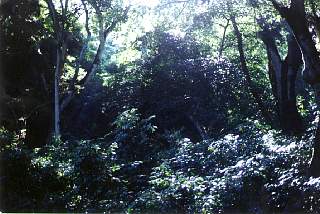
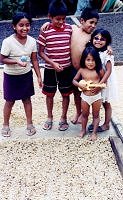
# Consequences of Farmers converting to other crops
Environment – Coffee is usually grown under a canopy of native shade trees. This forest cover provides habitat for migratory birds and functions to protect the watershed from soil erosion. As soon as coffee farmers begin converting their farms to peanut or corn production as people in the Sierra Madre are saying they will, the trees will be cut down. The consequences for the ecology of tropical regions will be severe.
The fact that coffee has been left unharvested has increased the risk of pest infestation, making it difficult to farm organically. According to the Organic Coffee Association’s list of the “Dirty Dozen” chemicals used on coffee farms, several of the most commonly used poisons are highly toxic to birds.
Implications for the Availability of Quality Coffee from Unique Origins: So many factors affect the quality of coffee at the level of the farm. These include soils, climate, altitude, sun, and the care with which this labor-intensive crop is handled throughout the year. Coffee grown at higher altitude has better characteristics. Both Brazil and Vietnam, the two largest producers of coffee, produce coffee at low altitude, with Brazilian farms producing without shade trees. These are not considered good coffees. We are at great risk of losing farms with more favorable conditions for producing unique coffees in the rest of the coffee-producing countries around the world. It takes five years for a new plant to begin to produce so it is doubtful that farmers would resume coffee production if prices were to improve.
Migration Pressures will Increase or “No me queda otro camino sino irme al norte” The survival of a very large percentage of families in the Sierra Madre already depends on relatives sent thousands of miles away to try their luck at crossing illegally into the U.S. to find work. The news is full of stories of campesinos who die in the desert or fall prey to cruel immigrant - “coyotes”, people who charge as much as $2000 dollars to supposedly deliver people safely in the U.S. where they will find work.
Situated as we are on the Guatemalan border in Chiapas, we see many young men from Central American countries whose families have similarly placed their hope in their making it to the U.S. Like in the Sierra Madre, many have not overcome the losses suffered with Hurricane Mitch. Imagine what it would be like at age 19 to take only a bit of cash that relatives have put together and to travel through several unknown countries, chased all the time by immigration officers, just to get to the line demarking the promised land.
PLEASE SEE COFFEE SOLUTIONS SECTION TO LEARN OF OUR WORK TO FIND SOLUTIONS
# Definition of Sustainable Trade From the Institute for Environment and Development
Sustainable trade takes place when the international exchange of goods and services yields positive social, economic and environmental benefits, reflecting the four core criteria of sustainable development:
- it generates economic value...
- it reduces poverty and inequality...
- it regenerates the environmental resource base, and...
- it is carried out within an open and accountable system of governance
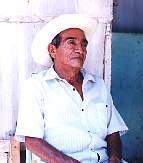
# The following article appeared in the Sept/ Oct. Issues of the Chronicle of the Specialty Coffee Association of America
# Small Scale Coffee Growers Reach Toward Self Sufficiency in the Sierra Madre of Chiapas, México
There is much talk these days about sustainable coffee as coffee buyers and consumers have become more aware of the environmental impact of coffee production in the developing world. But for coffee to be truly sustainable, the welfare of the small-scale farming families who produce the coffee must form part of the equation along with migratory birds, the elimination of chemicals and concerns about water quality.
In the Mexican State of Chiapas, the Sierra Madre Mountains rise sharply from the coastal plains formed by 46 rivers. The warm air cools as it rises up the slopes from the steamy rainforests of the lower elevations and turns to mist in the high coffee farms. It is a vast region where thousands of small-scale coffee farmers work their shaded lands with the desire each year that the harvest will finally provide enough to adequately sustain their families. But so far, it never quite does.
The Sierra Madre has eight municipalities and scores of tiny hamlets of subsistence farmers clinging to steep slopes that were deforested years ago by commercial logging and now are a patchwork of cornfields. It remains the poorest region in a state that has seen indigenous communities hundreds of miles to the north take up arms in frustration at their impoverished conditions. Despite the fact that the small-scale coffee producers of the Sierra Madre bring tons of high altitude Arabica coffee to market each year, the poverty of this region is stubbornly entrenched.
The cause is simple. Lacking capital to fund the costs of harvesting and processing their coffee, small-scale producers find no alternative than to reluctantly accept loans from middlemen called “coyotes”. The indebtedness obliges them to sell to the coyote for a price set among their peers who allow themselves a nice profit margin based on New York pricing. Responsible to laborers from nearby Guatemala, who must be fed while they wait to be paid, the farmers feel the pressure to sell immediately upon harvest.
Under this system known throughout Latin America as “coyotismo”, there is no incentive to control quality. Everyone knows that the coyotes routinely mix in inferior coffee with the good so as to pass on volumes to the transnational corporations that market to Europe and the U.S. Quality is not rewarded with a fitting price. Therefore it does not become cost-effective to order the pickers to leave greens on the branch for a second and third harvest. As one grower explained, “Unlike in the past when we picked carefully, now they take it all in one sweep. With what we can afford to pay, it has deteriorated to this.”
Government development programs aimed at assisting the farmers to improve their harvests effectively end up benefiting the coyotes. “What is missing from the scheme is the most important piece -- adequate information and assistance in marketing their coffee independently from the middlemen,” says Francisco Barrios, who organizes small-scale producers so that they can export. But organizing these growers is a challenging task. Many have had bad experiences with so-called democratic organizations over the years; some Fair Trade labeled. Barrios explains, “They have been lied to and given false promises only to see the leaders of the organizations grow conspicuously rich while they remain in the same precarious conditions as always.”
Francisco Barrios, who was born in the Sierra Madre and as a young man rode his motorcycle into the farthest reaches of the mountains, has known many coffee farmers since his childhood when they would come out of the mountains to buy supplies in his family’s general store in Motozintla. Reflecting on the difficulties of his beleaguered state of Chiapas he came to the conclusion that through organized marketing in sufficient volumes of quality coffee, the farmers could obtain a fair price.
But his vision does not stop there. Coffee is a fragile crop as we saw last year when drought, fires which spread from the yearly practice of burning cornfields, and finally three devastating hurricanes destroyed over 80% of the harvest. Added to this disaster was the blow of some of the lowest prices in recent memory. For this reason, Barrios promotes the creation of a fund from the coffee exported by small grower-organizations which will then seed other businesses eventually providing the self-sufficiency needed to eliminate the need for loans to finance the harvest. “In the Sierra there is a sleeping potential in the women who now spend all their time slaving away at tedious domestic tasks. When they have their own businesses they will have the freedom to contribute to the family economy. Then they can finally be free of the coyotes.”
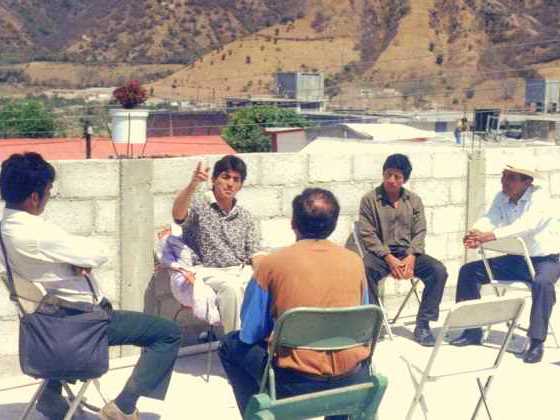
# Francisco Barrios with Sierra Oro Co-op Directors
This is precisely what the newly formed organization of 26 families Cerro de la Olla is attempting to do. With the help of the Sexto Sol Center for Community Action, a U.S. non-profit of which Barrios is co-founder, the women are seeking seed money to allow them to build a poultry business. Forget the notion of “small-scale” here, their goal is to raise 10,000 chickens. Thus liberated from the urgency to sell to coyotes for much need cash at the moment of the harvest, the growers can store their coffee for export.
The women are thrilled at the idea of delving into the new adventure of becoming businesswomen and all the challenges and joys that will bring them. “Together we will face whatever difficulties,” one woman said. This is impressive in a culture where the admitted obstacles to collective action envidia, a destructive form of jealously, and individualismo, the propensity to isolation, often destroy social organizations. These families are aware that they are pioneers in this new strategy to achieve self-sufficiency. But with the harvest coming in only a few short months, the families are hard-pressed to find the means to establish their business so that they can be free to export.
Convinced of the economic advantage of direct marketing their coffee, they are committed to producing quality coffee in an environmentally responsible way. Once the start-up capital is found and the business is producing, funds will be used to meet the heavy expense of technical training in how to prepare their cafetales for future organic certification. They are hopeful that the unique qualities of their coffee will command a price independent of the vagaries of New York, which, from their vantage point, has nothing to do with the realities of life in the mountains where ruins still preserve the ancient pottery and jade carvings of their Maya ancestors. With the small-scale growers directing the marketing of their ecologically produced coffee, supported by diverse collective enterprises, they will finally achieve a truly sustainable production and will do so with dignity.
 The Sexto Sol Center
The Sexto Sol Center